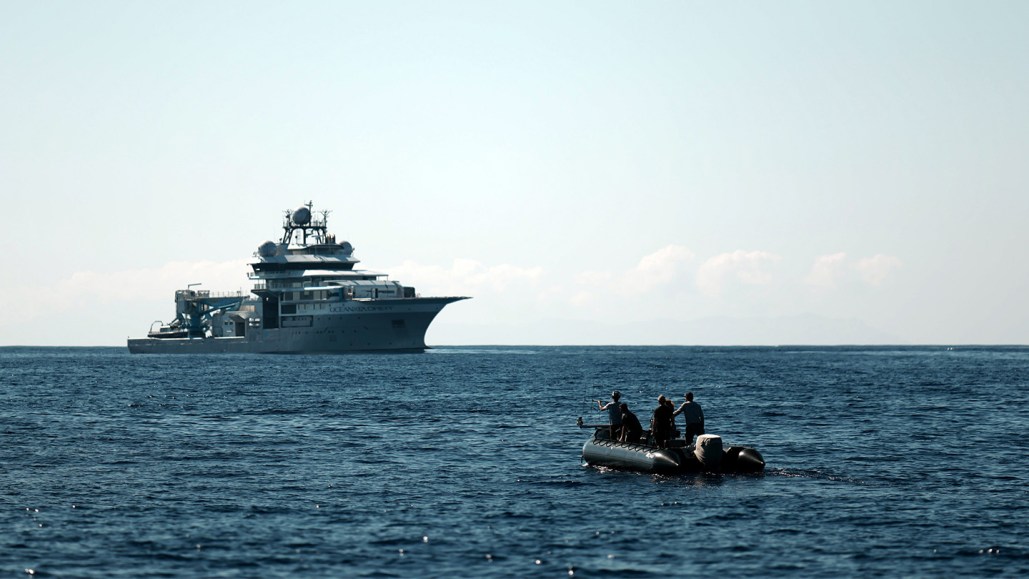National Geographic’s ‘OceanXplorers’ Explores the Ocean’s Most Enigmatic Depths

More than 70 percent of Earth’s surface is covered by ocean. But more than 80 percent of that marine realm is unknown. A crew aboard one of the world’s most advanced research vessels is exploring some of that uncharted water — and you can go along for the adventure.
From James Cameron, OceanXplorers is a documentary series on the National Geographic channel that follows researchers and explorers aboard the OceanXplorer, a ship outfitted with a helicopter, deep-sea submersible, remotely operated vehicle and even a holographic virtual reality lab that helps the team visualize the goings-on in the deep sea (SN: 9/15/23). OceanXplorer is owned by the nonprofit organization OceanX.
Science News is collecting reader questions about how to navigate our planet's changing climate.
What do you want to know about extreme heat and how it can lead to extreme weather events?
Over six episodes, viewers tag along for expeditions to study marine life in the shallow, tropical waters of the Caribbean, the seemingly unending depths of the Atlantic Ocean and along the frigid shores of the Arctic Ocean. Not surprising for a series executive-produced and narrated by Cameron, OceanXplorers takes every stereotype of the calm, relaxing nature documentary, secures it to a baited camera trap and tosses it out for the sharks. The vibe is definitely more Shark Week than David Attenborough, but the science is still front and center.
Now airing on the National Geographic channel and streaming on Disney+ and Hulu
In the second episode, for example, the team hopes to observe how sperm whales near the Azores islands in the North Atlantic dive. The blocky-headed whales can plunge a mile deep for up to an hour at a time, the documentary explains (SN: 4/8/16). But the buoyancy of their huge lungs and blubber should make that feat nearly impossible.
Sperm whales dive so deep that it had never been filmed before, the documentary notes. One challenge was building a camera tag to attach to a whale that can withstand the immense pressure of a dive. Viewers watch the mission’s ocean technology innovator, Eric Stackpole, and ship guest Rui Prieto, a whale biologist, take on that engineering problem. Once that’s ready, there’s another challenge to overcome — attaching the camera.
Sperm whales around the Azores were hunted as recently as 1987, and so the long-lived whales, which can reach up to 70 years old, are wary of ships and appear hesitant around the massive OceanXplorer. To attach the camera, two members of the research team — shark biologist Melissa Cristina Márquez and Aldo Kane, formerly of the Royal Marines — join Prieto on an inflatable motorboat to search for a pod.
Meanwhile, Stackpole gets on the ship’s helicopter and serves as an eye in the sky. After he directs the motorboat toward a pod, a sperm whale breaches. While most people might feel nervous being so close to the world’s largest toothed predators, Márquez’s face lights up on seeing the whale pop out of the water and she laughs. She explains that breaching may be a method of communication between family members.
This light-hearted moment is just one that makes OceanXplorers feel like a conversation rather than a lecture. But the series never doubts the intelligence of its audience, always explaining the intention and purpose of each experiment and device utilized to ensure viewers can follow along on each mission.
In the water, the team attaches the camera tag to a whale and retrieves it eight hours later. Stackpole and Prietro breathe a sigh of relief and celebrate their success.
The footage reveals that at nearly 275 meters deep, the sperm whale’s fluke stops moving almost entirely. From then on, gravity does most of the work for the diving whale, which saves oxygen and energy by not moving while descending to approximately 455 meters below the surface. It doesn’t start actively moving again until it starts echolocating to hunt by releasing sonar clicks (SN: 12/12/19). The whale is unsuccessful and after a while journeys back to the surface. (Watch the full episode to learn what the whales hunt down there.)
After sending out a family call near the surface, a second sperm whale appears and swims with the tagged whale. Stackpoke and Prieto are in awe watching the scene. “Nothing like that has ever been filmed,” Prieto says while wiping tears from his eyes.
Ultimately, OceanXplorers is full of heart. Joy and excitement permeate each episode as the crew explores the unknown, and emotions run high whenever the explorers witness the fruits of their labor.
As Stackpole says: “Exploring the deep, you often see something that you have never seen before. But you hope that you’re going to see something no one has seen before.”
Questions or comments on this article? E-mail us at [email protected] | Reprints FAQ
Abby Wallace is the digital engagement producer at Science News. She holds a bachelor's degree in biology from George Washington University in Washington, D.C., and a master's degree in journalism from the University of Maryland — College Park.
We are at a critical time and supporting climate journalism is more important than ever. Science News and our parent organization, the Society for Science, need your help to strengthen environmental literacy and ensure that our response to climate change is informed by science.
Please subscribe to Science News and add $16 to expand science literacy and understanding.




